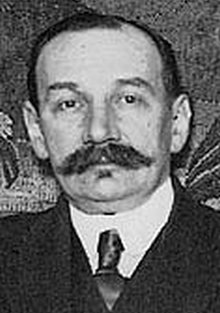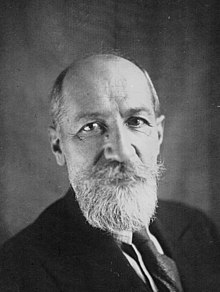
Aisne is a French department in the Hauts-de-France region of northern France. It is named after the river Aisne. In 2019, it had a population of 531,345.

Château-Thierry is a French commune situated in the department of the Aisne, in the administrative region of Hauts-de-France, and in the historic Province of Champagne.

Albert Auguste Gabriel Hanotaux, known as Gabriel Hanotaux was a French statesman and historian.

Paul Maximilien Landowski was a French monument sculptor of Polish descent. His best-known work is Christ the Redeemer in Rio de Janeiro, Brazil.
The Minister of Transport is a cabinet member in the Government of France. The position was created in 1870 as a modification to the position of Minister of Public Works (1830–1870). It has frequently been combined with the position of Minister of Public Works, Minister of Housing (Logement), Minister of Tourism, Minister of Territorial Development, and Minister of the Sea.

Michel Simon was a Swiss-French actor. He appeared in many notable French films, including La Chienne (1931), Boudu Saved from Drowning (1932), L'Atalante (1934), Port of Shadows (1938), The Head (1959), and The Train (1964).

Jean Mistler was a French writer, diplomat and politician born in Sorèze, Tarn. In 1966 he was elected to the Académie française.
The Prefect of Saint Pierre and Miquelon is the local representative of the President of France and in effect the Governor or Executive officer of the territory.

Paul Moreau-Vauthier was a French sculptor.

André Rossi was a French politician. He was France's Minister of Foreign Trade from 25 August 1976 to 31 March 1978, Mayor of Château-Thierry of 1971 to 1989, and Deputy of Aisne from 1958 to 1981, and 1986 to 1994, then Secretary of State, government spokesman from 28 May 1974 to 25 August 1976, before becoming Minister of the Foreign trade.
André Roanne was a French actor. He began his career playing in short films, and acted in 91 films in total, most notably those of Fernandel. Most of his films were French; he did, however, also appear in German and Italian works, especially co-productions with French companies. He also served occasionally as an assistant director, screenwriter, technician, and film editor.

Thierry Sandre was a French writer, poet, essayist. He won the Prix Goncourt in 1924 for Le Chèvrefeuille.

The Human Rights Leagueof France is a Human Rights NGO association to observe, defend and promulgation of Rights Man within the French Republic in all spheres of public life. The LDH is a member of the International Federation of Human Rights Leagues (FIDH).

Élie Bloncourt was a French politician who represented the department of Aisne in the French National Assembly from 1936 to 1946. He was blinded by a shrapnel blast in the First World War and was part of the French resistance movement in World War II. He had a degree in philosophy and worked as a high school teacher, while also being involved in organizational works relating to veterans' affairs, pacifism and politics.

Charles Henri Pille was a French painter and illustrator.
Jean-Baptiste Lebas was a French Socialist politician, deputy to the National Assembly of France during the Third Republic, who served twice as minister under Léon Blum’s governments. He was mayor of Roubaix and member of the Resistance during World War II.

Benoît Frachon was a French metalworker and trade union leader who was one of the leaders of the French Communist Party and of the French Resistance during World War II (1939–45). He was Secretary-General of the Confédération générale du travail (CGT) from 1945 to 1967.

Joseph Marie Philippe Thierry was a French lawyer and politician. He was deputy for Bouches-du-Rhône from 1898 to 1918. He was Minister of Public Works in 1913 and Minister of Finance in 1917. As Minister of Finance he introduced reforms that made the newly introduced income tax more progressive.

Jacques Krabal is a French politician. He was elected to the French National Assembly on 17 June 2012, as part of the Radical Party of the Left and re-elected on 18 June 2017, as part of La République En Marche!, representing the 5th constituency of the department of Aisne. He was also elected Château-Thierry's mayor on 20 March 2008 and re-elected on 30 March 2014 until 5 July 2017.
For more information, see
Radical Party (France) .















